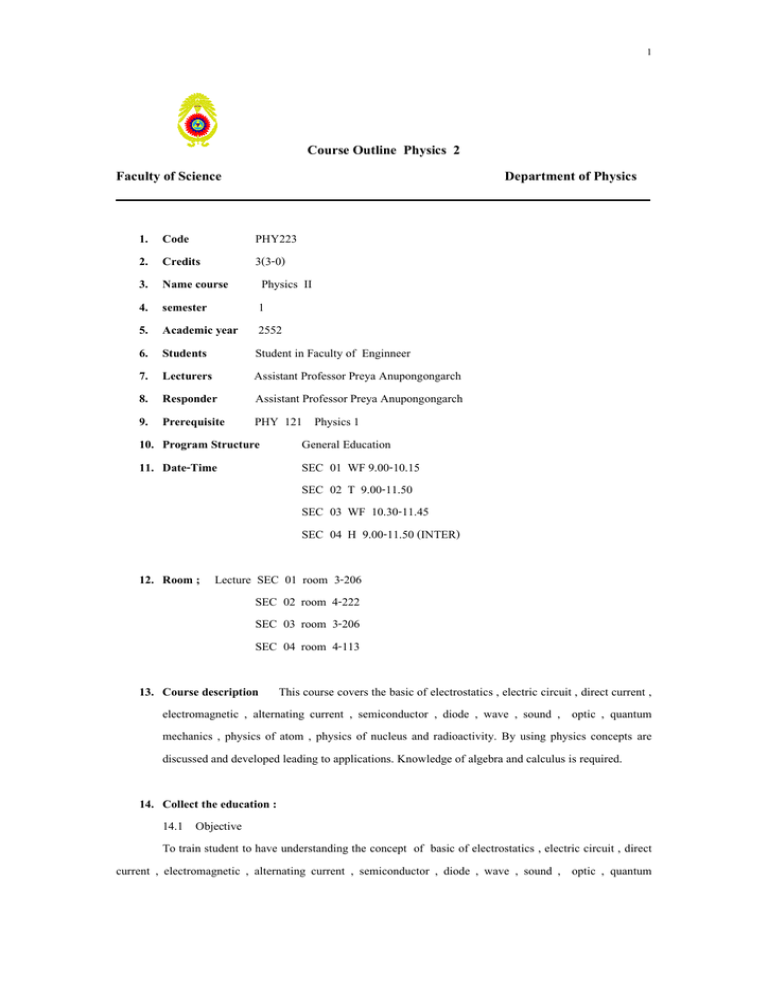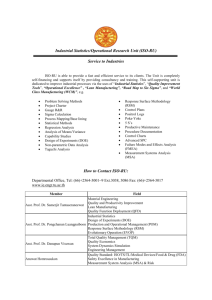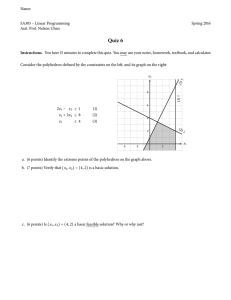Course Outline Physics 2 Faculty of Science Department of Physics
advertisement

1 Course Outline Physics 2 Faculty of Science 1. 2. 3. 4. 5. 6. 7. 8. 9. 10. 11. Department of Physics Code PHY223 Credits 3(3-0) Name course Physics II semester 1 Academic year 2552 Students Student in Faculty of Enginneer Lecturers Assistant Professor Preya Anupongongarch Responder Assistant Professor Preya Anupongongarch Prerequisite PHY 121 Physics 1 Program Structure General Education Date-Time SEC 01 WF 9.00-10.15 SEC 02 T 9.00-11.50 SEC 03 WF 10.30-11.45 SEC 04 H 9.00-11.50 (INTER) 12. Room ; Lecture SEC 01 room 3-206 SEC 02 room 4-222 SEC 03 room 3-206 SEC 04 room 4-113 13. Course description This course covers the basic of electrostatics , electric circuit , direct current , electromagnetic , alternating current , semiconductor , diode , wave , sound , optic , quantum mechanics , physics of atom , physics of nucleus and radioactivity. By using physics concepts are discussed and developed leading to applications. Knowledge of algebra and calculus is required. 14. Collect the education : 14.1 Objective To train student to have understanding the concept of basic of electrostatics , electric circuit , direct current , electromagnetic , alternating current , semiconductor , diode , wave , sound , optic , quantum 2 mechanics , physics of atom , physics of nucleus and radioactivity. And the student can use knowledge to applied for related fields. 14.2 Detail of Subject See in (14.3) 14.3 Detail of Subject / week Week 1 2 3 4 5 6 7 dd/mm/yy 10-12/06/09 Heading Introduce course and explain overall in this subject and teach in Chapter 1 1.1 Charge 1.2 Coulomb’s Law 17-19/06/09 1.3 Electric Field 1.4 Electric Flux 1.5 Gauss’s Law 24-26/06/09 1.6 Motion of charge in constant electric field 1.7 Potential energy and Electric Potential Chapter 2 Direct Current 2.1 Electric Current 2.2 Resistor , Resistance , Electric Power 2.3 Ohm’s Law and DC Circuit 1-3/07/09 2.4 Kirchhoff’s Law 2.5 Capacitance , Capacitor 8-10/07/09 2.6 Charge and discharge in RC Circuit Chapter 3 Electromagnetic 3.1 Magnetic Field • Biot - Savart Law 15-17/07/09 • Ampere’s Law 3.2 Magnetic force happens by moving charge in magnetic field. 3.3 Magnetic force happens by flowing current in wire. 3.4 Magnetic force happens by flowing current in two parallel wires. 22-24/07/09 3.5 Induced EMF 3.6 Faraday’s Law and Lenz’s Law 3.7 Self - Inductance Lecturer Asst.Prof.Preya Asst.Prof.Preya Asst.Prof.Preya Asst.Prof.Preya Asst.Prof.Preya Asst.Prof.Preya Asst.Prof.Preya 3 Week dd/mm/yy 8-9 10 26/07/09 12-14/08/09 11 19-21/08/09 12 26-28/08/09 13 2-4/09/09 14 9-11/09/09 15 16-18/09/09 16 23-25/09/09 17 30/9/09- Heading 3.8 RL Circuit Midterm Examination (see announcement in study room) Chapter 4 Alternating Current 4.1 R , C , L in AC circuit , rms 4.2 RLC Circuit • Series • Parallel RLC Circuit 4.3 Average Power 4.4 Resonance in RLC Circuit Chapter 5 Wave Sound 5.1 Speed of wave 5.2 Properties of Waves 5.3 Wave Function 5.4 Superposition and Standing Wave 5.5 Sound 5.6 Speed of sound 5.7 Intensity and Intensity Level 5.8 Doppler Effect Chapter 6 Electromagnetic waves and Optics 6.1 Electromagnetic waves 6.2 Properties of light 6.2.1 Law of Reflection , Image formation in concave mirror and convex mirror 6.2.2 Law of Refraction, Image formation in concave Lens and convex Lens 6.3 Far-Sight , Near-Sight , Optical Equipments Chapter 7 Quantum Physics & Nuclear Physics 7.1 Black Body Radiation 7.2 Plank’s Hypothesis 7.3 Wave – Particle Duality 7.4 Photoelectric Effect 7.5 Atomic Structure 7.6 X-Ray and LASER 7.7 Nuclear Structure Lecturer Asst.Prof.Preya Asst.Prof.Preya Asst.Prof.Preya Asst.Prof.Preya Asst.Prof.Preya Asst.Prof.Preya Asst.Prof.Preya Asst.Prof.Preya 4 Week dd/mm/yy 2/10/09 4/10/09 15. Activity 15.1 Teaching Heading 7.8 Binding Energy and Binding Energy per Nucleon 7.9 Types of Ray 7.10 Law of radioactive Decay 7.11 Fusion Reaction and Fission Reaction Final Examination (see announcement in study room) Lecturer 1. Narration 2. Self Learning with CAI , e –Learning 15.2 Learning Process 1. Self directed approach 2. Poblem based approach 16. Courseware 1.. CAI , e –Learning 17. Measurement : Lecture 100% 1. QUIZ 20 % 2. Assignments 20% 3. Midterm examination 30% 4. Final examination 30% 18. Evaluation: Condition of evaluate 18.1 To have studying time more than 80% 18.2 To pass when get the marks more than 50% 19. References 19.1 The textbook to be used : Preya Anupongongarch, Physics 2 & General Physics 2 John W. Jewett, Jr. , Raymond A. Serway, Physics for Scientists and Engineers with Modern Physics , Seventh Edition., Thomson Learning, Inc., 2008 19.2 The textbook to be used more read: 1. John D. Cutnell , Kenneth W.Johnson , Physics , John Wiley & Sons, Inc.,1998. 2. Hugh D. Young , Physics , Addison-Wesley Publishing Company ,Eighth Edition , 1992. 3. Thomus L.Floyd , Electric Circuits Fundamentals , Prentice-Hall International , Inc. Fourth Edition , 1998. 4. Douglas C. Giancoli , Physics For Scientists and Engineers with Modern Physics. second Edition Pretice - Hall , int , United Sate of America , 1988 19.3 E-Learning : Computer Simulation : http://www.rsu.ac.th/science/index_pom_sani.htm : http://www.rsu.ac.th/science/index_sama.htm 5 20. Assignment of weekly Time Assignment 1 Give Assignment Quiz Electrostatics 2 Quiz DC 3 Quiz Electromagnetic 4 Quiz Alternating current 5 Quiz Wave Sound and Light 6 Quiz Quantum Physics and Nuclear Physics 7 Sending in classroom in classroom in classroom in classroom in classroom in classroom in classroom


